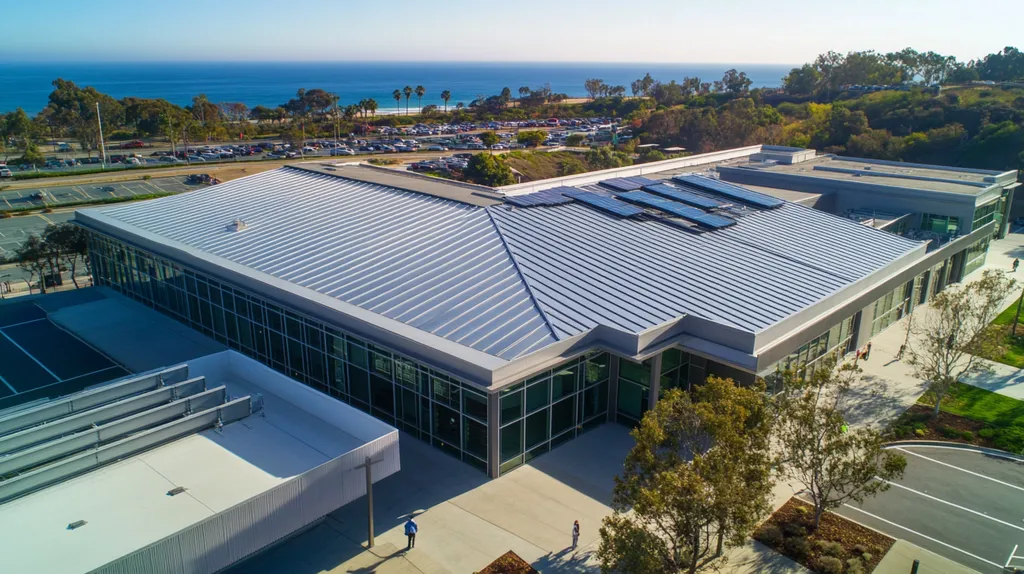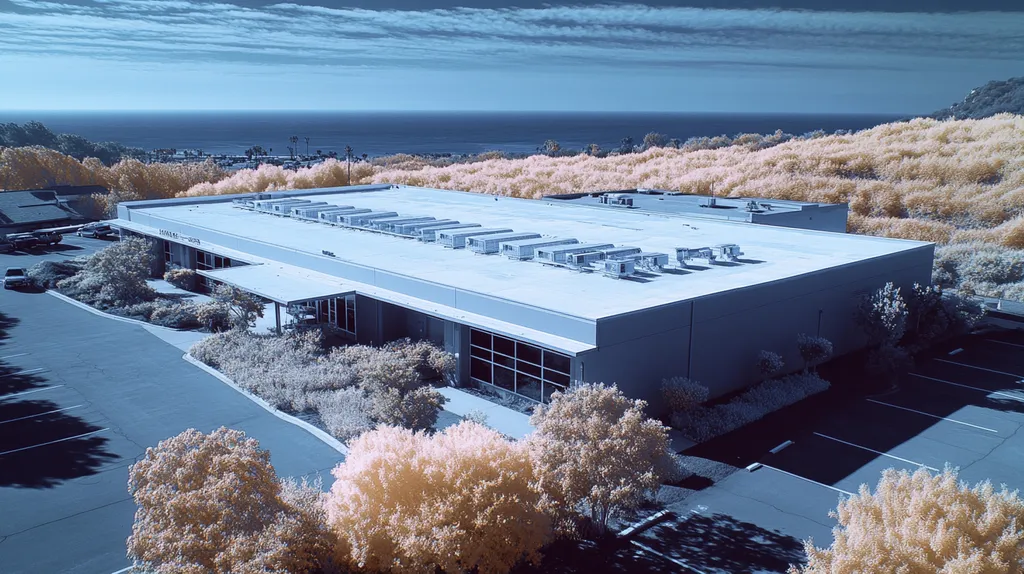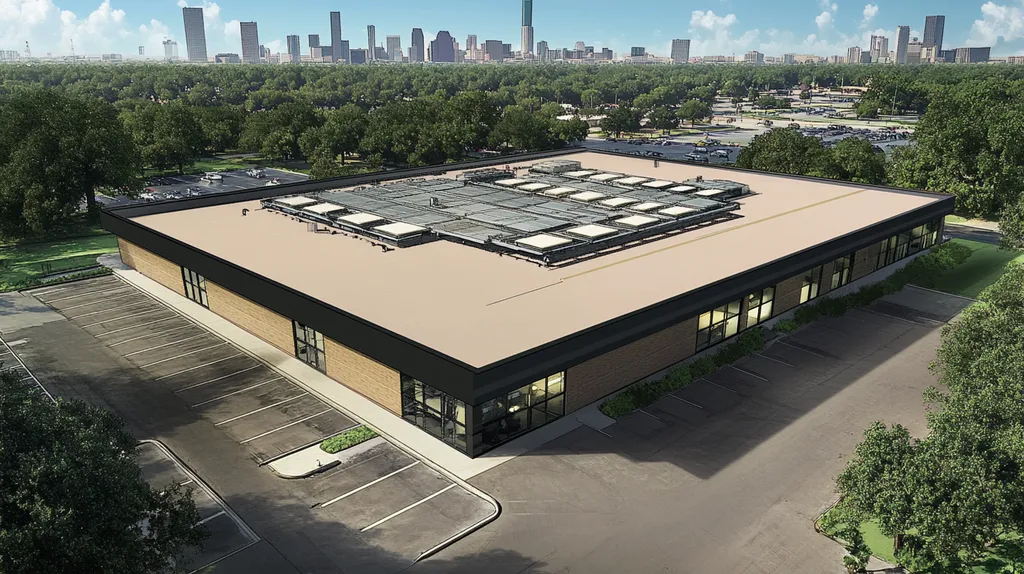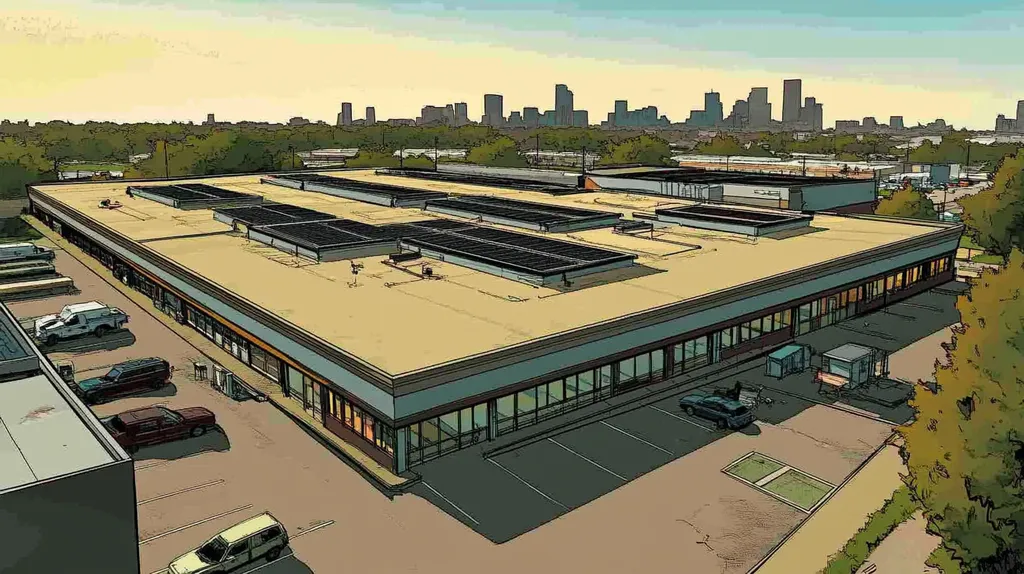In commercial roofing, a mere 1% error in roof slope calculation can lead to catastrophic water damage, costing property owners millions in repairs annually. The correlation between slope and roof performance has become increasingly critical as modern building designs push the boundaries of traditional architecture.
From drainage efficiency to material longevity, proper slope design fundamentally shapes every aspect of commercial roof performance. Recent industry studies indicate that up to 90% of premature roof failures can be traced back to inadequate slope considerations.
This comprehensive guide examines the intricate relationship between roof slope and commercial roofing performance, offering property owners and facility managers the essential knowledge needed to make informed decisions about their roofing systems.
SECTION 1: FUNDAMENTAL CONCEPTS
In the realm of commercial and industrial roofing, understanding roof slope is not just a technical detail; it is a matter of critical importance. The slope of a roof significantly influences water drainage, durability, and the overall structural integrity of a building. When the slope is inadequate, property owners may find themselves facing costly leaks and extensive water damage, making it imperative to have a solid grasp of these concepts for effective roof management.
Definition and Importance of Roof Slope
Roof slope, often termed pitch, describes the steepness of the roof surface. This is usually measured as a ratio, indicating the vertical rise for every horizontal foot. For instance, a slope of 4:12 means the roof rises 4 inches for every 12 inches it runs horizontally.
Understanding roof slope is vital because it directly affects how efficiently a roof can drain water. A roof with a proper slope prevents water accumulation, a common issue with flat roofs found in many commercial applications. Inadequate slope can result in unwanted pooling, leading to increased maintenance needs and unforeseen repair costs.
Moreover, the effectiveness of roofing materials often hinges on the slope. Recognizing the interplay between slope and material selection is essential for ensuring optimal roof performance. For example, some roofing membranes may fail prematurely if used on slopes below certain degrees, decreasing overall roof longevity.
In essence, a solid understanding of roof slope is fundamental to maximizing the lifespan and performance of commercial roofs. Rather than being just an aesthetic feature, the slope plays a strategic role in the overall health of the building.
Calculating Roof Slope Ratios
To effectively evaluate roof performance and drainage capabilities, calculating roof slope ratios is essential. This straightforward process, known as rise over run, determines the roof’s steepness and its ability to manage water runoff and structural load.
Begin by measuring the vertical rise and horizontal run in inches. Divide the rise by the run to arrive at the slope ratio. For example, if a roof rises 6 inches over a 12-inch run, the ratio would be 6:12.
It is important to realize that even slight variations in slope can dramatically influence water management efficacy. Many roofing systems have prescribed minimum slope requirements—around 1:40 is common for proper drainage. Adhering to these specifications is crucial to avoid structural issues and maintain the roof’s integrity.
Additionally, property managers should factor in local building codes when calculating slope ratios. Compliance with these regulations not only ensures safety but also helps prevent potential legal complications. Regular assessments and measurements are worthwhile investments that significantly contribute to effective roof management.
Impact of Slope on Roof Performance
The slope of a roof plays a pivotal role in determining its performance and longevity. An appropriately sloped roof encourages effective drainage, thereby reducing the risk of water pooling, which can lead to leaks, mold growth, and early degradation of roofing materials.
Conversely, flatter roofs often face drainage challenges, necessitating the implementation of additional design features such as scuppers or internal drainage systems. These considerations can increase both construction and maintenance costs, highlighting the importance of slope design from the outset.
Different roofing materials also respond uniquely to variations in slope. For example, asphalt shingles thrive on steeper slopes, while single-ply membranes are better suited for flatter surfaces. Recognizing these material characteristics is essential for maximizing roof performance.
Furthermore, selecting the right slope can enhance energy efficiency. Steeper roofs often improve ventilation and reduce heat retention, potentially lowering energy expenses. Thus, careful slope consideration is not just about structural integrity; it is also about achieving operational efficiency for the entire building.
SECTION 2: SYSTEM COMPONENTS
Choosing the right system components for a commercial roof is crucial, as the slope can dramatically impact its effectiveness. A poorly designed slope can lead to pooling water on flat roofs, resulting in costly repairs and potential structural damage. Selecting appropriate materials that align with the roof slope not only improves performance but also extends the lifespan of the roofing system. This section explores the various metal roofing options, evaluates material compatibility with different slopes, and highlights essential structural considerations for optimal roof performance.
Types of Metal Roofing Systems
Metal roofing systems have gained popularity in commercial settings for their robustness and appealing aesthetics. Standing seam metal roofs, characterized by their vertical panels that interlock, offer superior water resistance and minimize leak potential. Conversely, corrugated metal roofs are lightweight and cost-effective, making them suitable for low-slope applications.
Different metal roofing systems come with specific slope requirements. For instance, a standing seam roof can perform successfully with slopes as low as 1:12, while corrugated roofs typically need a minimum slope of 3:12 for adequate drainage. Property owners must choose a system tailored to the structure’s slope, safeguarding against costly maintenance in the long run.
Environmental factors also influence system selection. Roofs subjected to heavy snowfall will benefit from steeper slopes that effectively shed snow. Conversely, in arid regions, lower slopes can be viable without the risk of excessive water accumulation.
Ultimately, consulting with roofing professionals regarding system options and slope compatibility empowers property owners to make informed decisions that protect their investment while optimizing performance.
Roofing Materials and Slope Compatibility
The selection of roofing materials extends beyond aesthetics; it’s fundamentally linked to roof slope compatibility. Specific materials perform better at designated slopes. For example, single-ply membranes are ideal for flat roofs, providing a lightweight solution that requires precision installation to prevent water pooling.
In contrast, asphalt shingles thrive on pitched roofs where the slope exceeds a certain degree. Employing them on lower slopes can lead to rapid wear and reduced effectiveness due to improper drainage. Choosing materials compatible with the slope helps alleviate issues associated with water intrusion.
Additionally, the thermal performance of roofing materials can be influenced by the slope. Steeper slopes promote improved ventilation, reducing heat buildup. This not only elevates energy efficiency but also extends the life of the roofing materials.
Property owners should work closely with roofing professionals to assess material options that match their roof’s specific slope requirements, ensuring optimal performance while minimizing risks of damage.
Structural Elements and Slope Considerations
A comprehensive understanding of the structural elements related to roof slope is critical for maintaining the overall integrity of the roofing system. The trusses or rafters must adequately support the roofing structure. If the slope is too gradual, it may impede proper drainage, leading to water buildup and potentially compromising the structure.
Moreover, local building codes frequently establish minimum slope requirements for various roofing systems, which are essential for property owners to consider. Non-compliance can result in performance challenges and legal implications.
The choice of structural materials also significantly affects slope performance. Inadequate materials can lead to sagging, threatening the integrity of the roof. A well-designed slope is essential for effective water drainage while ensuring that structural components are adequately supported to minimize maintenance efforts.
Regular inspections and maintenance are crucial for monitoring any changes in roof slope resulting from structural settling. Engaging professionals for periodic evaluations ensures property owners meet safety standards while safeguarding their investment.
SECTION 3: IMPLEMENTATION METHODS
Properly selecting and implementing the right roof slope is crucial for maximizing the durability and effectiveness of a commercial roofing system. An incorrectly designed slope can lead to severe issues, including water pooling, costly leaks, and even structural failures. Property owners and facility managers must understand the steps involved in measuring and designing roof slope, the factors that influence slope selection, and the critical importance of adherence to local building codes. This section serves as a guide to navigating these vital considerations.
Measuring and Designing Roof Slope
Accurate measurement is foundational in creating an effective roof slope. Typically expressed as a ratio, such as 2:12, this indicates the rise over the run—meaning the roof rises 2 inches for every 12 inches of horizontal run. This calculation is crucial; improper slopes can impede water drainage, leading to serious maintenance issues.
Detailed planning is essential during installation to integrate necessary drainage components like gutters, downspouts, and scuppers, which help direct water away from the roof efficiently. Consideration of these features early on is key to a successful outcome.
Moreover, utilizing advanced measurement tools, such as digital inclinometers and laser levels, can significantly improve accuracy. This attention to detail during the design phase lays the groundwork for an efficient roofing system that effectively manages water runoff.
Ultimately, a precisely measured roof slope not only enhances drainage but also bolsters the overall integrity of the roof, minimizing the risks associated with inadequate slope.
Factors Influencing Slope Selection
Several interrelated factors come into play when selecting the right roof slope, and each choice carries implications for performance and maintenance. Local climate conditions are paramount; for instance, areas that experience heavy snowfall necessitate steeper slopes to efficiently shed snow, reducing excessive weight on the roof structure.
The roofing material itself also influences slope decisions. Materials like TPO and EPDM perform well on low to moderate slopes, while traditional asphalt shingles typically require steeper inclines to be effective. Understanding these interactions can significantly impact the roof’s long-term performance.
The architectural design of the building is another consideration. While aesthetic preferences can shape slope choices, they must also support the functional requirement of effective drainage. Balancing form and function leads to a more durable and reliable roofing system.
By grasping these factors, property owners can make informed decisions that enhance the resilience and efficiency of their roofs, ultimately leading to reduced upkeep costs.
Compliance with Local Building Codes
Following local building codes regarding roof slope is not just advisable; it is essential for ensuring safety and structural integrity. These codes are established to ensure roofs can withstand environmental forces and provide security for occupants. Non-compliance can result in fines, legal complications, and insurance issues.
Minimum slope requirements are common and may vary based on jurisdiction, climate, and building type. Property owners need to familiarize themselves with these regulations to create roofs that are safe and compliant.
Consulting local building authorities or experienced roofing professionals before diving into the design phase is also a wise move. Engaging with experts ensures that all compliance aspects are covered, preventing potential complications during construction.
Ultimately, adherence to building codes not only streamlines the construction process but also contributes to the long-lasting viability of the roofing system.
SECTION 4: MAINTENANCE REQUIREMENTS
Maintaining the right roof slope is essential for the longevity and performance of commercial roofs. Inadequate slope maintenance can lead to issues such as water pooling and structural damage, which often result in expensive repairs. Research indicates that commercial roofs with poor drainage can suffer a lifespan reduction of up to 50%. This section outlines essential maintenance practices that ensure proper water drainage, enhance wind resistance, and address safety concerns for steeper roofs.
Slope and Water Drainage Maintenance
Maintaining the roof slope is critical for effective water drainage. Clogged gutters and downspouts can lead to water pooling, raising the risk of leaks and significant structural damage. Routine inspections should prioritize debris removal to allow water to flow off the roof efficiently.
Property owners should plan maintenance checks before the rainy season. This proactive measure helps mitigate the risk of water-related issues, ultimately extending the roof’s lifespan. Regular cleaning and maintenance tasks should be integral to an annual roofing strategy.
With the appropriate slope, a roof can redirect water effectively. However, flat roofs demand more diligent attention to ensure drainage features, such as scuppers and drains, operate optimally.
Establishing a maintenance plan that includes documented inspections can facilitate early issue detection. Addressing minor problems before they escalate is vital for preserving roof integrity and long-term performance.
Wind Resistance and Slope Maintenance
Wind resistance is a critical consideration for sloped roofs, particularly in storm-prone regions. A well-maintained slope can reduce the forces of wind uplift, thereby lowering the risk of roof failure. During routine inspections, checking for loose shingles or tiles should be a key focus.
Enhancing professionalism among roofing teams is essential for effective slope maintenance related to wind resistance. Proper installation practices, coupled with regular assessments, are vital for sustained roof performance.
Utilizing materials specifically engineered for wind resistance can further bolster the roof’s durability. Ensuring the roofing material is suitable for local climate conditions adds an extra layer of protection.
Collaborating with roofing professionals can refine maintenance strategies. By focusing on wind resistance during slope inspections, property owners can enhance safety and increase their roof’s longevity.
Safety Considerations for Steeper Roofs
Steeper roofs pose unique safety challenges, particularly during maintenance activities. The risk of falls escalates, especially during inspections and repairs. Property owners should invest in proper safety equipment and training for personnel involved in roof maintenance.
Incorporating training on safety protocols specific to steeper slopes should be a regular part of the maintenance schedule. This preparation ensures that workers are informed about potential hazards when accessing elevated areas.
Utilizing appropriate ladders and harnesses is vital for minimizing fall risks. Establishing designated access routes can also improve safety for teams conducting maintenance work.
Lastly, evaluating the need for professional assistance with steep roof maintenance can prevent accidents. Hiring qualified roofers trained for steep slopes not only ensures safer conditions but also enhances long-term roof performance.
SECTION 5: PERFORMANCE METRICS
Evaluating how roof slope affects commercial roof performance is essential for property owners and facility managers. When slope is inadequate, it can lead to persistent issues such as poor drainage, diminished durability, and escalating energy costs. For example, a flat roof lacking proper design can cause significant water accumulation, triggering costly repairs and disrupting daily operations. This section will delve into critical performance metrics related to drainage efficiency, durability, and energy conservation.
Evaluating Drainage Efficiency
Drainage efficiency is vital for preventing water pooling and ensuring the structural integrity of a roof. A poor slope not only allows water to collect but also invites leaks and deterioration. In fact, studies reveal that approximately 85% of roof leaks stem from inadequate drainage systems.
When evaluating drainage, several metrics are crucial, including the slope ratio and drainage system capacity. A commonly recommended minimum slope of 1% is essential for effective water runoff. Regular inspections should actively seek out any blockages or damage affecting drainage systems.
Choosing suitable materials that enhance drainage capabilities can significantly alter performance outcomes. For example, tapered insulation systems can create necessary slopes where they are lacking, enabling water to flow away from critical areas.
Ultimately, effective drainage safeguards the roof from long-term damage and reduces maintenance costs. Investing in solid drainage solutions not only protects the roof but also prolongs its life, making it a valuable investment for property owners.
Assessing Durability and Longevity
Durability and longevity are crucial indicators of a roof’s capacity to withstand environmental challenges. Roof slope significantly impacts these attributes; steeper slopes effectively shed debris and moisture, reducing wear over time.
The choice of materials is also integral to durability. For instance, high-quality TPO (Thermoplastic Olefin) roofs perform markedly better on well-sloped surfaces than on flat ones. Insufficient slope often leads to premature failure, resulting in expensive replacements.
Regular maintenance checks should prioritize the integrity of the slope. Any cracks, bulges, or signs of settling must be addressed promptly to prevent further complications. Neglecting these aspects can escalate repair needs and decrease the roof’s lifespan.
By emphasizing slope during both the installation and maintenance phases, property owners can significantly enhance the durability and longevity of their roofs, thereby preserving their investment.
Energy Conservation and Slope
Energy efficiency is an increasingly pressing concern for commercial properties. Roof slope plays a direct role in heating and cooling costs, with flat roofs often absorbing excess heat, resulting in increased energy consumption during warmer months.
On the other hand, roofs designed with the right slope enable the effective installation of reflective materials and coatings. This approach can lower energy costs by enhancing thermal performance and reducing the strain on HVAC systems.
Additionally, sloped roofs encourage better ventilation, which aids in regulating temperature and humidity levels inside the building. This practice not only curtails energy usage but also promotes overall comfort for occupants.
Investing in a roof designed with optimal slope and insulation can yield significant long-term savings, making it a savvy choice for facility managers striving for both efficiency and sustainability.
SECTION 5: PERFORMANCE METRICS
Understanding how roof slope influences commercial roof performance is essential for property owners and facility managers. A poorly designed slope can lead to persistent issues like inadequate drainage, diminished durability, and soaring energy costs. For instance, a flat roof that lacks effective slope systems can result in significant water accumulation, causing costly repairs and operational disruptions. This section examines essential performance metrics that relate to drainage efficiency, durability, and energy conservation.
Evaluating Drainage Efficiency
Drainage efficiency is vital for preventing water pooling and ensuring a roof’s structural integrity. Without an appropriate slope, water can accumulate, leading to leaks and eventual damage. Studies indicate that around 85% of roof leaks are attributed to inadequate drainage systems.
When assessing drainage, specific metrics such as slope ratio and drainage system capacity are critical. Typically, a minimum slope of 1% is recommended for effective water runoff. Property managers should conduct regular inspections to identify blockages or damage within drainage systems.
Moreover, selecting appropriate materials that enhance drainage capabilities can greatly improve overall performance. For instance, tapered insulation systems can help create a necessary slope where it is lacking, effectively directing water away from crucial areas.
Ultimately, efficient drainage not only protects the roof from long-term damage but also reduces maintenance costs. Investing in robust drainage solutions is a key step in extending a roof’s lifespan, safeguarding the investment in the property.
Assessing Durability and Longevity
Durability and longevity serve as essential indicators of a roof’s ability to withstand environmental stressors. Roof slope significantly influences these qualities, as steeper slopes shed debris and moisture more effectively, preventing deterioration over time.
The choice of materials is equally important. For example, high-quality TPO (Thermoplastic Olefin) roofs perform considerably better on well-sloped surfaces than on flat ones. Insufficient slope often results in premature failure and leads to expensive replacements.
Regular maintenance checks should focus on the integrity of the slope. Any signs of cracks, bulges, or settling should be addressed swiftly to prevent further issues. Neglecting these details can increase repair needs and shorten the roof’s overall lifespan.
By prioritizing slope during both installation and maintenance, property owners can significantly enhance the durability and longevity of their roofs, ultimately preserving their investment.
Energy Conservation and Slope
Energy efficiency is a growing concern for commercial properties, and roof slope plays a direct role in heating and cooling costs. Flat roofs frequently absorb excess heat, leading to increased energy consumption, particularly in warmer months.
On the other hand, roofs designed with an appropriate slope facilitate the effective installation of reflective materials and coatings. This can lower energy costs by improving thermal performance and alleviating pressure on HVAC systems.
Additionally, sloped roofs promote better ventilation, which aids in regulating temperature and humidity levels within the building. This not only reduces energy usage but also enhances the overall comfort of occupants.
Ultimately, making the investment in a roof designed with optimal slope and insulation can lead to substantial cost savings over time, making it a smart choice for facility managers seeking efficiency and sustainability.
Looking Ahead
With over $4 billion spent annually on commercial roof repairs due to slope-related failures, the importance of proper slope design and maintenance cannot be overstated.
The evolution of roofing technology continues to underscore how critical slope calculations are to overall roof performance.
From the traditional built-up roofing systems of the 1950s to today’s advanced synthetic membranes, one constant remains: proper slope design determines success or failure.
As climate patterns become more extreme and building codes grow stricter, understanding the relationship between slope and performance will only become more crucial for property owners.
The future of commercial roofing lies in precise slope engineering, proactive maintenance, and integration with emerging sustainable technologies.
FREQUENTLY ASKED QUESTIONS
Q. How does roof slope affect commercial roof performance?
A. The slope of a roof is crucial for water drainage and overall durability. An inadequate slope leads to water pooling, risking structural integrity and increasing maintenance costs.
Q. What types of commercial roofs work well with varying slopes?
A. Different types of metal roofs, like standing seam and corrugated, have specific slope requirements. Selecting the right material for the appropriate slope prevents leaks and enhances performance.
Q. How can I properly measure and design roof slope?
A. Measuring roof slope involves calculating the rise over the run, typically expressed as a ratio. Accurate measurements are essential for effective drainage and should include drainage system planning.
Q. What maintenance is required to preserve roof slope?
A. Maintenance includes regular inspections to clear debris from gutters and downspouts to prevent pooling. Addressing any drainage issues promptly ensures the roof’s longevity and effective performance.
Q. How does roof slope influence energy costs in commercial buildings?
A. Proper roof slope enhances ventilation and allows for reflective materials, reducing heat absorption. This can lead to significant savings on heating and cooling expenses throughout the year.
Q. What building codes should I consider for commercial roof slopes?
A. Local building codes often dictate minimum slope requirements based on climate and building type. Familiarizing yourself with these codes is essential for compliance and structure safety.
Q. Can green roofing systems be used on commercial roofs?
A. Yes, but green roofs typically require specific slope considerations for effective drainage. Proper design helps ensure that the added weight of vegetation does not compromise roof integrity.











